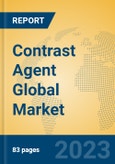Regional Market Trends
The contrast agent market varies across regions, driven by healthcare infrastructure, imaging procedure volumes, and regulatory environments.- North America: The United States leads with a CAGR of 2.8%-5.5%, driven by high imaging procedure volumes, advanced healthcare systems, and adoption of novel agents. Canada contributes with a focus on MRI and CT diagnostics.
- Europe: Germany, France, and the United Kingdom are key markets, with a CAGR of 2.5%-5.0%. Growth is supported by robust healthcare systems and demand for safer agents, though regulatory restrictions on gadolinium limit expansion.
- Asia-Pacific: China and Japan drive growth with a CAGR of 4.0%-7.5%. China’s expanding healthcare infrastructure and Japan’s advanced imaging technologies boost demand for iodinated and gadolinium-based agents. India shows potential due to increasing generics adoption.
- Latin America: Brazil and Mexico have a CAGR of 3.0%-6.0%, driven by rising healthcare access and diagnostic imaging demand. Cost-effective generics support growth.
- Middle East and Africa (MEA): The region, including Saudi Arabia and South Africa, has a CAGR of 3.5%-6.5%. Growth is driven by improving healthcare infrastructure, but limited access to advanced agents constrains potential.
Application Analysis
The contrast agent market is segmented by application and type, each with distinct growth trends.- CT: Dominated by iodinated agents, this application has a CAGR of 2.8%-5.5%, driven by high CT procedure volumes for diagnosing cardiovascular and oncological conditions.
- MRI: Gadolinium- and manganese-based agents drive this segment, with a CAGR of 3.0%-6.0%. Demand for safer alternatives to gadolinium, like manganese-based agents, is rising.
- X-Ray & Fluorescence: Primarily uses iodinated agents, with a CAGR of 2.5%-5.0%, supported by widespread use in general diagnostics.
- PET/SPECT: This niche segment has a CAGR of 3.5%-6.5%, driven by specialized agents for oncology and neurology imaging.
- Ultrasound: Microbubble agents drive this segment, with a CAGR of 4.0%-7.0%, supported by growing adoption in cardiovascular and liver imaging.
Type Analysis
- Gadolinium-containing Contrast Agent: Used in MRI, with a CAGR of 2.5%-5.5%. Safety concerns drive demand for alternatives, but generics sustain growth.
- Iodinated Contrast Agent: Dominant in CT and X-ray, with a CAGR of 2.8%-5.8%. Non-ionic agents like iodixanol lead due to improved safety.
- Manganese-based Contrast Agent: A growing segment with a CAGR of 3.5%-6.8%, driven by its potential as a safer MRI alternative.
- Photoacoustic Contrast Agent: A niche segment with a CAGR of 4.0%-7.5%, supported by emerging imaging technologies.
- Microbubble Contrast Agent: Used in ultrasound, with a CAGR of 4.2%-7.2%, driven by advancements in cardiovascular imaging.
- Others: Including novel agents, with a CAGR of 3.0%-6.5%, driven by innovation in PET/SPECT and fluorescence imaging.
Selected Company Profiles
- Bayer: Markets Ultravist (iodinated) and Gadovist (gadolinium), generating USD 0.9-1.5 billion in 2024. Patent expirations drive generic competition, but Bayer’s global reach sustains leadership.
- Bracco: A leader in iodinated and gadolinium-based agents, generating USD 1-2 billion in 2024, with a strong presence in Europe and North America.
- GE Healthcare: Markets iodinated and gadolinium-based agents, focusing on integrated imaging solutions for CT and MRI.
- Guerbet: Offers iodinated and gadolinium-based agents, with a focus on safety and innovation in Europe and Asia-Pacific.
- Ascelia Pharma AB: Specializes in manganese-based agents, targeting safer MRI alternatives with growth potential.
Industry Value Chain Analysis
The contrast agent value chain begins with R&D, developing agents with improved safety and efficacy through chemical synthesis and clinical trials. Manufacturing involves producing APIs for iodinated and gadolinium-based agents or microbubbles for ultrasound, adhering to strict quality standards. Distribution leverages global supply chains, ensuring availability through hospitals and imaging centers. Marketing targets radiologists and healthcare providers, emphasizing diagnostic accuracy and safety.Healthcare providers administer contrast agents during imaging procedures, with patient safety monitored through pharmacovigilance. The value chain is supported by regulatory approvals and reimbursement systems, with leading companies integrating R&D, manufacturing, and distribution to optimize efficiency.
Opportunities and Challenges
Opportunities:
- Rising Imaging Demand: Increasing prevalence of chronic diseases drives demand for diagnostic imaging and contrast agents.
- Safer Agents: Innovations in non-ionic iodinated and manganese-based agents address safety concerns, boosting adoption.
- Emerging Markets: Expanding healthcare infrastructure in Asia-Pacific and Latin America offers growth potential.
- Technological Advancements: Advances in imaging modalities like photoacoustic and ultrasound imaging support new agent development.
Challenges:
- Safety Concerns: Risks of gadolinium retention and iodinated agent nephrotoxicity limit adoption and drive regulatory scrutiny.
- Patent Expirations: Expirations for agents like Ultravist and Gadovist increase generic competition, pressuring revenues.
- Pricing Pressures: Cost containment by payers limits profitability, particularly in Europe.
- Regulatory Hurdles: Stringent approval processes for new agents increase development costs.
This product will be delivered within 1-3 business days.
Table of Contents
Companies Mentioned
- Bayer
- Bracco
- GE Healthcare
- Guerbet
- Ascelia Pharma AB
- FUJIFILM
- Jiangsu Hengrui Medicine Co. Ltd.
- Yangzijiang Pharmaceutical Group
- Beijing Beilu Pharmaceutical Co. Ltd.
- iMAX Diagnostic Imaging
- Sanochemia








